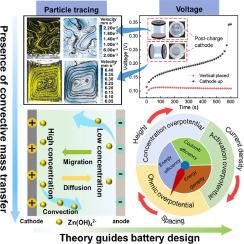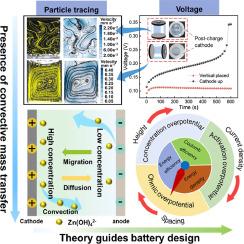Revealing the intricacies of natural convection: A key factor in aqueous zinc battery design
IF 18.9
1区 材料科学
Q1 CHEMISTRY, PHYSICAL
引用次数: 0
Abstract
Aqueous zinc-based batteries offer high safety, abundant resources, low cost, and environmental friendliness, making them a promising alternative to lithium-ion batteries for large-scale energy storage markets. However, the natural convection in the electrolyte during operation, which can greatly affect the battery performance, is overlooked for a long time. Through particle tracing experiments, this study demonstrates that in the vertical placement of the battery, natural convection occurs due to the variation of electrolyte density, whereas it does not happen when the cathode is on top. Besides, there is a significant difference in electrochemical performance between these two configurations, with a voltage difference of up to 0.25 V at 10 mA cm⁻² and a peak current difference of up to 3.4 mA in linear sweep voltammetry. Simulation results show that convective mass transfer can be up to 100 times greater than diffusive mass transfer in a bulk solution. This highlights the importance of considering natural convection to improve model accuracy. Further, to increase energy density, batteries are scaled up in practical applications to reduce the weight of the casing. This work simulates mass transfer conditions under various scenarios, illustrating the trade-off between current density and battery size, and offering new guidance for the design of aqueous zinc-based batteries.


揭示自然对流的复杂性:水性锌电池设计的关键因素
锌基水基电池具有安全性高、资源丰富、成本低廉、环境友好等特点,是锂离子电池的替代品,在大规模储能市场中大有可为。然而,长期以来,电解液在运行过程中的自然对流会极大地影响电池的性能,这一点一直被忽视。本研究通过粒子追踪实验证明,在电池垂直放置的情况下,由于电解液密度的变化会产生自然对流,而当正极在顶部时则不会发生自然对流。此外,这两种配置之间的电化学性能也存在显著差异,在 10 mA cm-² 的条件下,电压差可达 0.25 V,线性扫描伏安法的峰值电流差可达 3.4 mA。模拟结果表明,在块状溶液中,对流传质比扩散传质最多可高出 100 倍。这突出了考虑自然对流以提高模型精度的重要性。此外,为了提高能量密度,电池在实际应用中被放大以减轻外壳重量。这项研究模拟了各种情况下的传质条件,说明了电流密度和电池尺寸之间的权衡,为锌基水性电池的设计提供了新的指导。
本文章由计算机程序翻译,如有差异,请以英文原文为准。
求助全文
约1分钟内获得全文
求助全文
来源期刊

Energy Storage Materials
Materials Science-General Materials Science
CiteScore
33.00
自引率
5.90%
发文量
652
审稿时长
27 days
期刊介绍:
Energy Storage Materials is a global interdisciplinary journal dedicated to sharing scientific and technological advancements in materials and devices for advanced energy storage and related energy conversion, such as in metal-O2 batteries. The journal features comprehensive research articles, including full papers and short communications, as well as authoritative feature articles and reviews by leading experts in the field.
Energy Storage Materials covers a wide range of topics, including the synthesis, fabrication, structure, properties, performance, and technological applications of energy storage materials. Additionally, the journal explores strategies, policies, and developments in the field of energy storage materials and devices for sustainable energy.
Published papers are selected based on their scientific and technological significance, their ability to provide valuable new knowledge, and their relevance to the international research community.
 求助内容:
求助内容: 应助结果提醒方式:
应助结果提醒方式:


